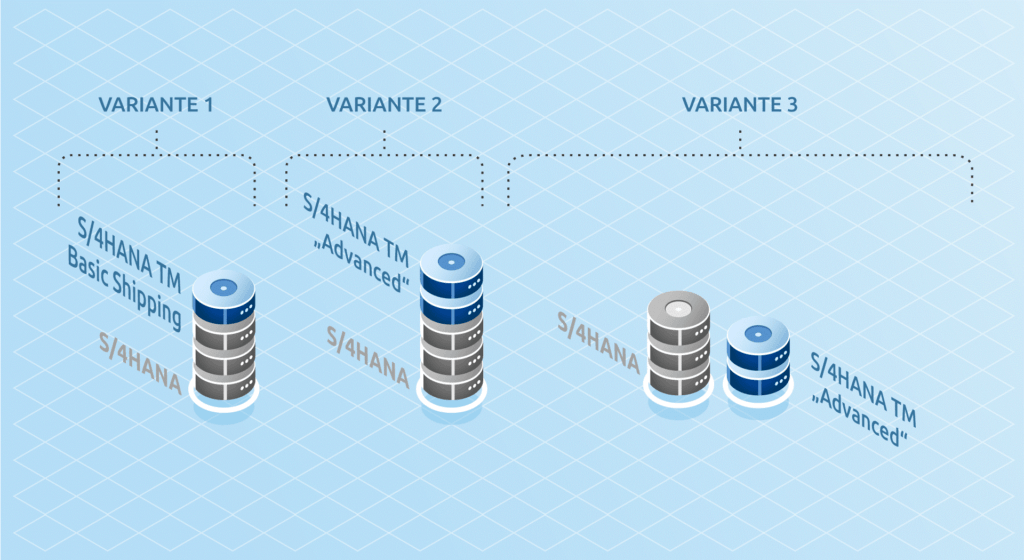Does S/4HANA TM guarantee a real benefit compared to LE-TRA? Or is the lifespan limitation the only reason for a change?
SAP announced the end of support for LE-TRA for the 31st of December 2027. As an option, SAP offers extended maintenance until the end of 2030. S/4HANA TM Basic Shipping was announced as the new way to model transportation processes in SAP and shall cover the full functionality of LE-TRA. But is S/4HANA TM Basic Shipping really an alternative solution to support your transport logistics in the same way?
LE-TRA
The Transportation sub-module of Logistics Execution in SAP ERP is called LE-TRA. It is widely used by companies to model transportation services, spanning from transportation planning to execution and freight cost settlement.
S/4HANA TM
In addition, another SAP software solution has existed for over 10 years; SAP TM (Transportation Management). The TM functionalities were only available in a separate system before 2017, however, this is no longer necessary. Now, they are also available “embedded” in S/4HANA. The official name for the S/4HANA-based TM is “SAP S/4HANA Supply Chain for Transportation Management”.
Deployment options of the S/4HANA-based TM

The variants differ both in scope and license models. All corresponding functionalities that were previously covered by LE-TRA can be used in S/4HANA TM Basic Shipping without the need for a special SAP S/4HANA Supply Chain for Transportation Management license.
S/4HANA TM Basic Shipping concentrates exclusively on “shippers”, i.e. the manufacturing industry.
In contrast, the “Advanced” variant with its wide range of additional functionalities (such as optimizer-based transport and load planning) is also aimed at logistics service providers.
What does the "Basic" option cover?
The functional scope of the S/4HANA TM Basic Shipping includes:
- Late transportation planning based on deliveries
- Plan either grouped inbound or grouped outbound (no combination) transportation demand (i.e. based on deliveries)
- Manual planning and monitoring
- Manual carrier selection
- Basic charge calculation and freight settlement
Which objects are the sam? Which are different?

Transportation planning and dispatching
| LE-TRA | S/4HANA TM BASIC SHIPPING |
|---|---|
| Shipment document | Freight Order |
| Print / E-Mail of papers or EDI paper on SAP condition technique | technique Print / E-Mail of papers or EDI based on Output Management with the Post-Processing Framework (PPF) |
The counterpart to the LE-TRA shipment document in TM is the freight order. For this object, communication with third parties usually takes place, for example the assignment of the freight forwarder or the generation of required transport documents. As in the LE-TRA, a basic dangerous goods check is supported.
In contrast to the LE-TRA, where deliveries are assigned directly to the shipment document, the assignment to the TM freight order takes place via a new object, the freight unit, which is created based on the delivery.
There are two shortcomings in the Basic Shipping scope of use:
- The Transportation-Cockpit – an interactive cockpit for planning – is not included
- The automatic creation of freight orders, e.g. via a batch job, is not supported
Organizational Management
| LE-TRA | S/4HANA TM BASIC SHIPPING |
|---|---|
| Transportation Planning Point as organizational unit | Organizational unit (Purchasing Organization) only mandatory if freight charges are to be calculated |
A shipment document can only be created in the LE-TRA if a certain, so-called “transportation planning point” is specified as an organizational unit. This usually corresponds to a group of employees. In order to settle freight costs, on the one hand, the transportation planning point is assigned to a company code. A TM freight order, on the other hand, – as surprising as it may sound for “old-school SAP ERP guys” – could in principle be created without any organizational unit. However, in the case of the TM, an organizational unit is required for the freight settlement.
Charge calculation and freight settlement
| LE-TRA | S/4HANA TM BASIC SHIPPING |
|---|---|
| Shipment cost document | Freight Settlement Document |
| Calculation of expected costs using SAP condition technique, high customizing effort | Calculation of expected costs via flexibly combinable master data objects (freight agreements, rate tables, etc.) |
| Cost distribution and account assignment in shipment cost document | Agency business document for detailed cost distribution |
| Transfer of calculated freight costs to the goods billing document to the customer | Possible since S/4HANA TM 1909 |
The shipment cost document in LE-TRA corresponds to the freight settlement document in TM. The relationship between the freight order and the freight settlement document is n:m, no longer 1:1. In addition, the expected costs are already visible in the freight order, not only in the freight settlement document.
The calculation of costs via TM-specific master data objects without overly complex customizing enables key users to store the agreed rates in the system to a certain extent “independently of the IT department”. In addition, the maintenance of rates in TM is greatly simplified by a standard integration with MS Excel.
The integration in freight settlement and controlling (SAP FI/CO) is largely comparable to that known from LE-TRA.
Essential difference
At first glance, the difference between LE-TRA and S/4HANA TM Basic Shipping seems merely a wording change. However, a closer look reveals a more differentiated picture.
It is certain that S/4HANA TM Basic Shipping does not currently represent 100% of the features of LE-TRA. It is highly regrettable that the transportation cockpit is not available – SAP does not even offer a “reduced” version in Basic Shipping. Apart from that, all important functions are already available today.
How do i get from LE-TRA to TM?
There is currently no migration path from LE-TRA to S/4HANA TM Basic Shipping – and if one considers, for example, the complexity of freight rates that hardly any SAP customer stores in SAP ERP in exactly the same way using SAP condition technology, it is highly questionable whether a purely system-related migration to the completely differently structured objects of the “new world” would make sense at all.
For these reasons, we recommend that you start the changeover in good time before the clock strikes 12 and LE-TRA is no longer available.
Which option suits me best?
Ultimately, the extent to which the “New World” S/4HANA generates benefits and the relationship between input and output must be examined on a case-by-case basis.
The extended possibilities that the TM in the “Advanced” variant has to offer, and which are constantly being further developed by SAP, should also be taken into consideration.
We at leogistics would like to accompany you on this journey and would like to introduce ourselves as your travel companion. Create your individual travel route with us for conversion to S/4HANA Transportation Management (S/4HANA TM Migration). Together we will examine your business needs and create a roadmap.
We would be happy to advise you on all these questions relating to transport logistics!
Annemarie Hose
Janine Härtel
Christine Kettner
Consultants SAP Logistics




